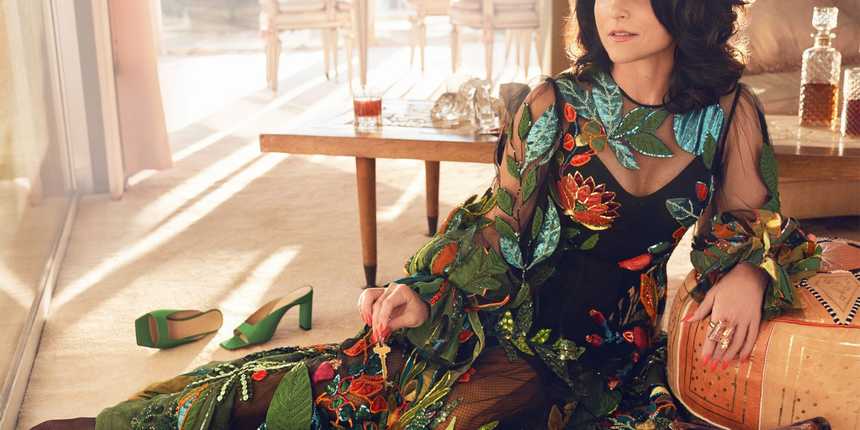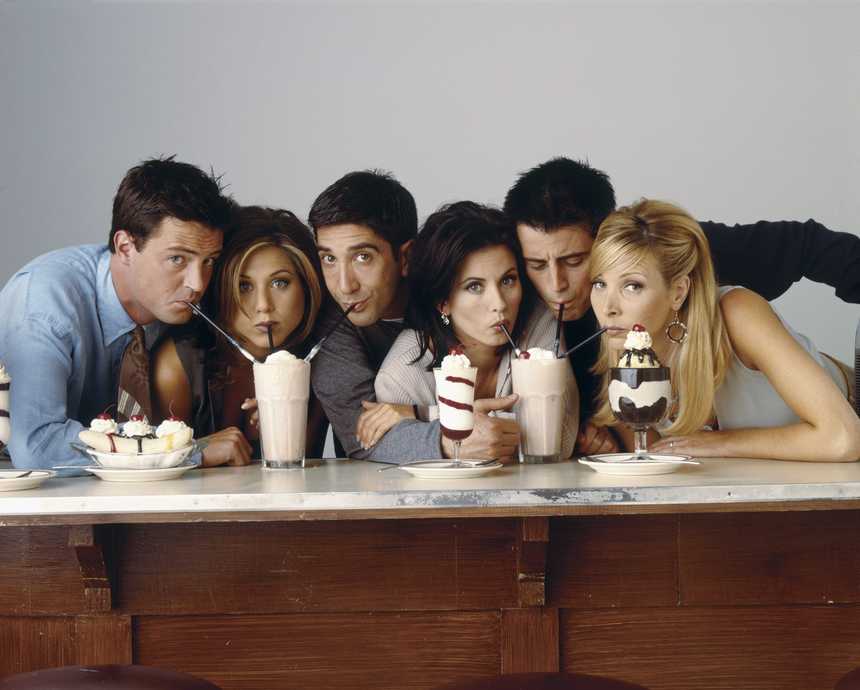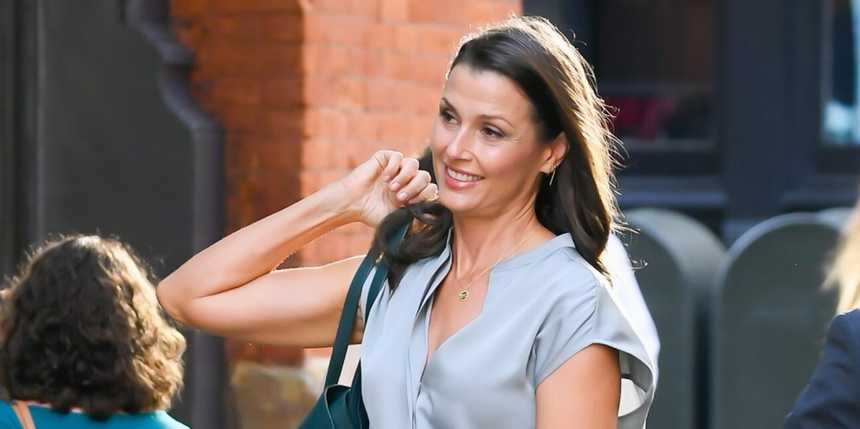Julia Louis-Dreyfus on Her Health, Career, and Activism

Among the great comic scenes that Julia Louis-Dreyfus has delivered in her 38-year career, there’s a brief one from 2015 that many women — especially women in Hollywood — remember as a standout. It’s a five-minute sketch on Inside Amy Schumer that mocks the notion that actresses instantly lose all attractiveness once they reach a certain age. Schumer is walking near a lake when she spots Louis-Dreyfus at a picnic table with Tina Fey and Patricia Arquette, feasting on wine and macarons while blithely celebrating Louis-Dreyfus’s “last fuckable day.” The women cheer as Louis-Dreyfus chugs a pint of melted ice cream and belches loudly. Then they wish her luck with her future of playing grandma roles and send her off in a rowboat.
Five years later, as Louis-Dreyfus, 59, sips coffee in a beachside Santa Monica restaurant, she doesn’t mince words about her actual state of desirability. “I feel very fuckable!” she says. Then she laughs and admits that she was unexpectedly plagued with doubts while shooting the scene. (Several major over-40 actresses had declined to be cast, unwilling to confront the loaded topic of ageism.) “All of a sudden I thought, ‘Wait a minute, why is this funny?’” Louis-Dreyfus recalls. But she recovered and ended up improvising some of the skit’s best lines. “That’s just the kind of thing I like to skewer,” she says.
VIDEO: Woman With Bar and Chair — Julia Louis-Dreyfus on How to Deal with A**holes
If you sit down for a chat with Louis-Dreyfus these days, you can expect more than just a stream of glib one-liners. As reflexively ironic and playful as she often is, her frank, sincere side keeps popping through. Granted, the best comedians rarely turn out to be nonstop jokesters in person, but if you’ve spent more than three decades watching Louis-Dreyfus wisecrack her way to 11 Emmy Awards (three for producing and eight for acting, on Seinfeld, The New Adventures of Old Christine and Veep), it’s hard not to expect her every utterance to be a gag or at least a sardonic aside. In fact, whether the topic is politics or feminism or her recent battle with breast cancer, Louis-Dreyfus has a way of speaking the truth when it counts. She tells me that being outspoken doesn’t necessarily come naturally to her, so she often has to push herself toward it. “I’ve always been very opinionated, but, honestly, I’m constantly fighting that female kind of mode: ‘Should I say it? I’m sorry!’ But in my head, I’m always like, ‘Do it, do it, do it.’”
In Louis-Dreyfus’s latest movie, Downhill, the serious and the silly are closely interconnected. A darkly comic remake of the acclaimed 2014 Swedish film Force Majeure, it follows an American family of four on a ski trip in the Austrian Alps, where a scary incident on the mountain — they’re nearly injured in an avalanche — sparks a marriage crisis. As the hard-charging mother, Billie, Louis-Dreyfus has a range of half-buried emotions to explore, and in one intense scene she cries real-deal tears while confronting Will Ferrell, who plays her beta-male husband. On the lighter side there’s a slapstick mishap while Billie is masturbating in a bathroom stall following a flirtation with a hot Italian ski instructor.
 Julia Louis-Dreyfus Credit: Renato Cipullo ring. Sergio Rossi pumps. Carter Smith/Copious Management
Julia Louis-Dreyfus Credit: Renato Cipullo ring. Sergio Rossi pumps. Carter Smith/Copious Management
When it comes to technique and timing, Louis-Dreyfus says, dramatic material is really no different from comedy. “It’s the same,” she says. “I mean, you’re not always mining for laughs, but — at the risk of sounding like an asshole actor — if you’re really doing what you should be doing, you’re always looking for truth.” In some ways the acting was the easy part of Downhill; as a producer, Louis-Dreyfus devoted five years to the project, hiring the writer (Jesse Armstrong) and directors (Nat Faxon and Jim Rash) and overseeing casting while she developed her own character. “It was hyper-important to me that Billie was not just a great mother always doing the right thing,” she says. “That there were gray areas and that she was a very well-rounded person.”
Speaking of full-fledged women, it’s instructive to take a look back at Seinfeld, the show that first made Louis-Dreyfus a star back in 1990. During its nine-year run there were many days when Louis-Dreyfus was not just the only female onscreen but one of the few on the entire set, and throughout the first few seasons Louis-Dreyfus was continually nudging creators Jerry Seinfeld and Larry David to add more substance to her character, Elaine Benes. But Louis-Dreyfus knew that Elaine was groundbreaking in subtle ways that weren’t always apparent at the time. “I was one of four players, the rest of whom were men, and we were all equally unlikable,” Louis-Dreyfus says. “And I wasn’t selling romance or sex appeal — it was about something else. That was really important.”
 Julia Louis-Dreyfus Credit: Etro dress. Sylvia Toledano earrings. Oscar de la Renta bracelet. Bulgari rings. Carter Smith/Copious Management
Julia Louis-Dreyfus Credit: Etro dress. Sylvia Toledano earrings. Oscar de la Renta bracelet. Bulgari rings. Carter Smith/Copious Management
Of Seinfeld’s four main players, Louis-Dreyfus is also the only one whose career didn’t peak with the show. I ask her if she can explain why. Luck, she insists, is a big part of it. “I actually do think that there’s an enormous amount of luck in having things line up in this town, more than people care to admit.” But then she offers another reason that seems far more plausible: “I really like to work. And I’m determined to find excellent material, which is not necessarily the easiest thing to do. I just have an intense desire to keep going. Working as an actor and finding material really sustain me.”
That much was evident to anyone who saw how Louis-Dreyfus reacted to her cancer diagnosis in 2017. Although receiving the news was “so fundamentally terrifying,” she didn’t fully grasp how difficult chemotherapy would be and figured it would just require some tweaks to the schedule of Veep, which was about to start production on its final season. “I called Dave Mandel, who was our showrunner,” she recalls. “I said, ‘OK, so I’ve got this disease, but chemo is every three weeks, and I’ll just need a little downtime right after each treatment. So if we can just break for those couple of days?’” Soon it became clear that the show would have to go on hiatus. But even during her treatments, while she was physically “very diminished,” Louis-Dreyfus kept meeting with her co-stars for table reads. “And that was fantastic,” she says. “Because it kept me hopeful, and I could focus on work instead of…trying to stay alive.” She raises an eyebrow. “You know, making a funny show is a pretty joyful undertaking. As opposed to, say, getting chemotherapy toxins in your veins.”
 Julia Louis-Dreyfus Credit: Marc Jacobs jumpsuit. Earrings, her own. Carter Smith/Copious Management
Julia Louis-Dreyfus Credit: Marc Jacobs jumpsuit. Earrings, her own. Carter Smith/Copious Management
The seventh season of Veep was always meant to be its last, but Louis-Dreyfus acknowledges that in the aftermath of the 2016 presidential election, the unbridled egos and venal self-interest of Washington, D.C., became almost impossible to parody. “The White House is now making a better version of the show, but it’s completely unfunny,” she says. As for next November’s election, she’s waiting for the right moment to publicly get behind one of the Democratic candidates, but on the red carpet at Veep’s final-season première she tipped her hand when a reporter asked her whether she thought she’d see a female president in her lifetime. “I fucking better,” she said.
Louis-Dreyfus has been one of Hollywood’s most consistently vocal environmental activists, and she recently took on a bigger role on the board of the Natural Resources Defense Council, which has sued the Trump administration at least 100 times to block actions that are poised to threaten species or speed up climate change. “The truth is, the planet is going to be fine — because it’s going to eradicate the human population if we don’t get our shit together,” she says. “There has to be a complete recalibration of how we conduct ourselves and do business.” On the health-care front Louis-Dreyfus used her social-media accounts as her megaphone during her illness, repeatedly pushing for universal coverage. “I had felt strongly about the issue before, but now, here it was, stark and real,” she says. “The notion that someone might have a diagnosis like that and have no insurance, no means to get treatment, was inconceivable to me.”
 Julia Louis-Dreyfus Credit: Alberta Ferretti dress. Carter Smith/Copious Management
Julia Louis-Dreyfus Credit: Alberta Ferretti dress. Carter Smith/Copious Management
Since her recovery Louis-Dreyfus is finding herself “even more laser-focused” than before in most areas of her life. “I’m keenly aware of the fact that I’m not immortal,” she says. She has learned Transcendental Meditation and stepped up her workout regimen, now exercising “like a maniac.” For anyone who sees her in Oscar de la Renta at a première these days, it’s hard to believe how recently she was sick — or that while growing up in Washington, D.C., she thought of herself as the family’s ugly duckling. “Well, I was,” she says. “I didn’t have a normal, beautiful look. I’m sort of, you know — big nose, massive head.” When did she start to realize she was attractive? “Maybe, like, an hour ago?” She laughs and adds, “Honestly, I think it truly started to change in my 30s and 40s.”
Although comedians aren’t known as the world’s most stylish bunch (their bad rap is “probably deserved,” Louis-Dreyfus says), over the years she’s been an elegant and increasingly enthusiastic adopter of looks from marquee designers such as Narciso Rodriguez and Brandon Maxwell. “I do love fashion,” she says. Pointing to the high-waist Helmut Lang army fatigues and Blundstone boots she’s wearing today, she adds, “Clearly, I also like to be comfortable. It’s nice to get dressed up for the red carpet, but when you get home, it’s also nice to take those clothes off and just wear comfortable shit.”
Louis-Dreyfus has been in a famously happy marriage to fellow Saturday Night Live alum Brad Hall for almost 33 years. They have two grown sons, several beautiful homes, etc., etc. As we finish our coffees, I ask if there’s anything that magazine articles tend to get wrong about her. She’s silent for a while.
 Julia Louis-Dreyfus Credit: Marc Jacobs blazer and pants. Carter Smith/Copious Management
Julia Louis-Dreyfus Credit: Marc Jacobs blazer and pants. Carter Smith/Copious Management
“I think sometimes it seems like my life has been, you know, easy livin’,” she says.
“Maybe I come off as cavalier about things. But I’ve really worked hard.” She pauses again, as if setting up a joke. She’s smiling, but the punch line doesn’t come.
“That’s all,” she says. Then she hugs me goodbye and heads to her next meeting.
Photography: Carter Smith. Styling: Cristina Ehrlich. Hair: Aviva Perea for SWA Agency. Makeup: Rachel Goodwin for Streeters. Manicure: Emi Kudo for Opus Beauty. Manicure by Emi Kudo using Chanel Le Vernis. Prop styling: Daniel Horowitz for Jones Mgmt. Production: Kelsey Stevens Productions. Hand-lettering: @writtenbywilliam.
For more stories like this, pick up the March issue of InStyle available on newsstands, on Amazon, and for digital download Feb. 14.


